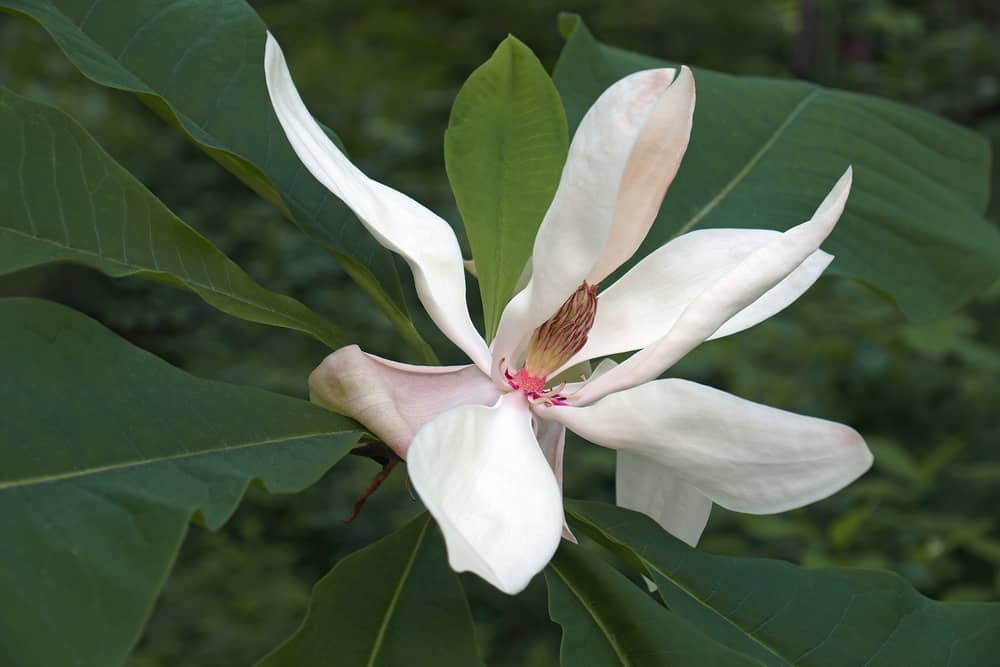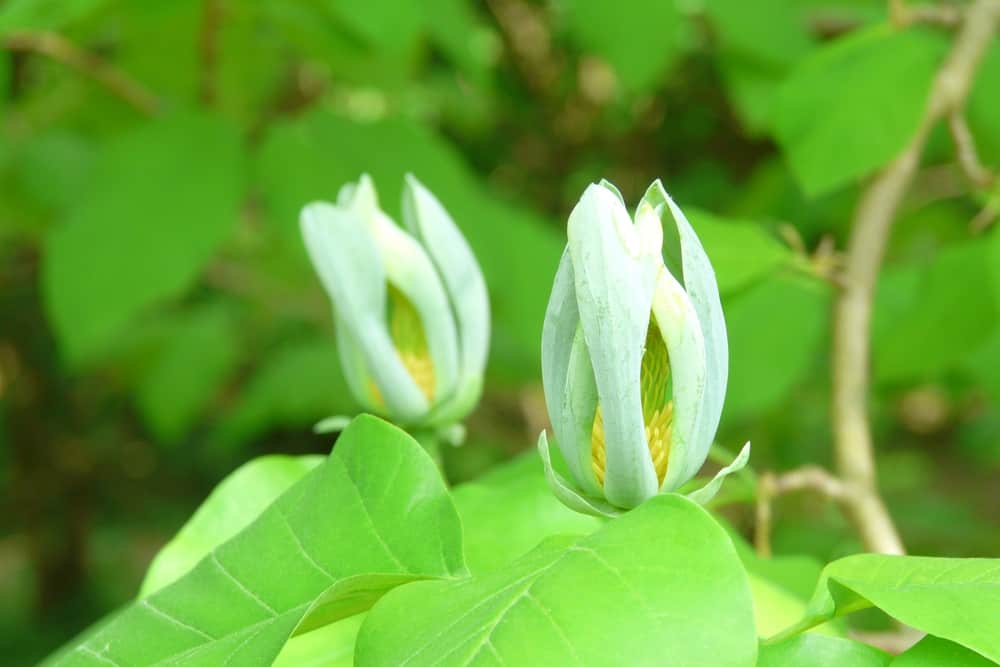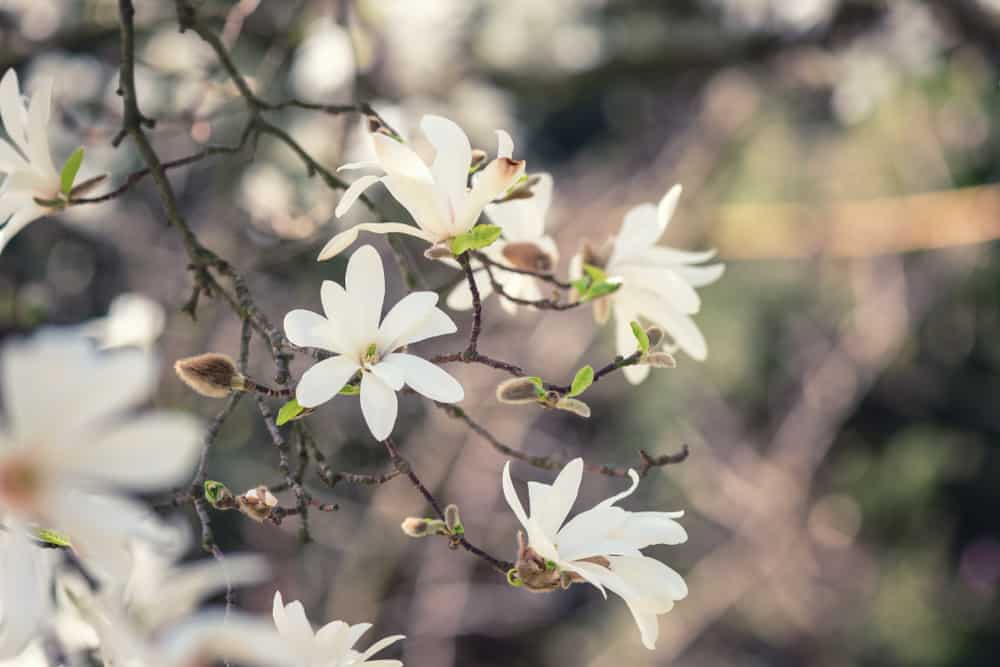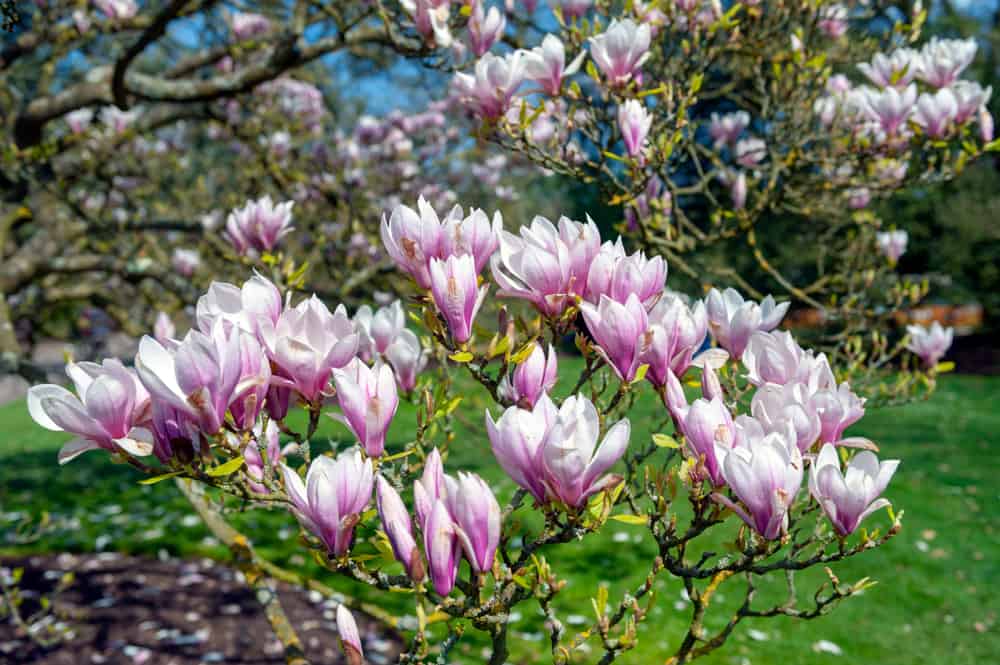Sweet Magnolias. Steel Magnolias. However you look at it, magnolia trees have captivated our imaginations and noses. While large fragrant blossoms often characterize these plants and flowers, there are actually multiple types of magnolias. Some are trees while others are bushes. Here, we look at some of the most common magnolia trees.
Types of Magnolia Trees
There are actually over 200 varieties of magnolias. Some are hybrid versions of other species. Magnolias can grow on shrubs as well as trees. There are even varieties that can be grown as shrubs or small trees. We’ve outlined some of the most common magnolia trees and where you can find them.
Bigleaf Magnolia

Flower of Bigleaf magnolia (Magnolia macrophylla)
©Nikolay Kurzenko/Shutterstock.com
The name of Bigleaf Magnolias is quite appropriate. They are named for the large leaves that they have, often up to 30 inches. They grow to around 30 or 40 feet tall and are often cultivated for gardens and landscaping. These large trees aren’t found in the environment often outside of some parts of the southeastern United States.
Ashes Magnolia
These trees grow in the Florida panhandle and bring an interesting beauty to the wild landscape. The flowers are white with purple speckling near the inside. They can be up to 6-12 inches across and are easy to spot in the trees. The leaves are also large and can be up to 1-2 feet. The trees grow to be around 25 feet tall.
The leaves are a lighter, brighter green than some other magnolia varieties. They do have whiteish undersides. They bloom in April, with pollinated fruits appearing in the late summer around August. Interestingly, they are only native to a very small portion of Florida. Their native habitat is limited to just a few counties. Due to this, these trees are considered endangered and you should never remove one from the wild.
Cucumber Tree Magnolia

Flower of Magnolia acuminata (Cucumber tree)
©Anna Krzywania/Shutterstock.com
If you think that the cucumber tree magnolia is an odd name, you’ll love to see the cucumber-like green fruits that appear on this tree in late summer. Cucumber Tree magnolias grow up to 60-80 feet tall and have small yellowish-green flowers that bloom in late spring. They do have a slight scent but nothing like the smell of other larger varieties that has become synonymous with magnolia.
They are native to dense forests in North Carolina and love to grow over rocks in moist to dry climates. There are a few cultivated varieties that have slight differences in flowers, leaves, and height.
Lily Magnolia
These large magnolia trees have rich green leaves that turn golden in the fall. Their flowers, which bloom in late spring, can be up to 6 inches in diameter. Fortunately for gardeners, these flowers come in a wide range of beautiful colors depending on the variety of trees. Colors include copper, gold, lavender, and burgundy. There are also varieties that grow lower to the ground more like a shrub.
Kobus Magnolia

Flowering magnolia kobus branch in spring garden
©Uhryn Larysa/Shutterstock.com
The delicate blossoms of the Kobus Magnolia appear earlier than most other magnolia trees. They are cream-colored and start opening as early as March. They do take a long time to fully mature, up to 30 years. While they do bloom before that, the flowers on young Kobus magnolia trees are less striking than those on mature plants.
The flowers open before leaves come back to the tree, resulting in a striking appearance in the early Spring. The leaves are green and smooth. They also have a nice fragrance. They turn gold and yellow in the fall before falling off the tree in the winter.
Loebner Magnolia
This white-blossoming magnolia tree is actually a hybrid species of two other varieties, M. kobus or Kobus magnolia and M. stellata or Star magnolia. It has star-shaped flowers that are 3-5 inches in diameter. While the flowers are often white they can also be tinted with pink or purple, although it is very subtle. The flowers give off the heavenly magnolia scent and appear in the late spring.
Saucer Magnolia

Flowering branches of Saucer magnolia (Magnolia x soulangeana), a hybrid plant in the genus Magnolia and family Magnoliaceae with large, early blooming flowers
©Gaid Kornsilapa/Shutterstock.com
The low branches of the Saucer magnolia hold deliciously fragrant blossoms shaped like saucers, giving the tree its name. The flowers are white but have plenty of deep pink and even purple on their petals. The leaves are dark green. Because of the rich colors of both the leaves and flowers, these magnolias are popular in landscaping and gardening. They grow up to 30 feet tall. The branches do hang low, giving observers a chance to marvel at the flowers and leaves, as well as enjoy the scent.
Southern Magnolia
If you visualize a magnolia tree, chances are you are thinking of a Southern magnolia. Also known as a Loblolly magnolia or Evergreen magnolia, these trees have large creamy white blossoms that give off one of the most iconic scents in the flower world. The flowers themselves are large and spread out. The petals lay flat and cup at the ends. The leaves are shiny green on top and rust-colored below. The contrast between the colors of a magnolia tree makes a beautiful natural statement.
Unfortunately, the bloom window for magnolia flowers is quite short. They only bloom for around two weeks before they turn brown and start to wrinkle. Eventually, the flowers fall off and red seed pods appear, bringing about new magnolia trees.
Star Magnolia

Teal and orange filtered closeup of star magnolia flowers and branches in sunlight
©SwedishStockPhotos/Shutterstock.com
White flowers make a statement when seen on a fully blossoming Star magnolia tree. They are often bright white and, though small, give off a wonderful scent. The leaves are dark green, giving a stark contrast to the white flowers. The bark is grey and one of the most easily recognized parts of this variety of magnolia tree. The trees grow to 15-20 feet tall, one of the smaller varieties. Their leaves and branches spread out around 15 feet in diameter. One of the best parts of the star magnolia is that the groupings of flowers are very thick, resulting in a beautiful flowering tree and smell.
Sweetbay Magnolia
This smaller tree creates beautiful delicate magnolia blossoms that are creamy white. The dark green leaves have silver undersides, making it a popular decorative tree. They grow up to 20 feet at their largest and spread out between 10 and 20 feet when fully mature. Sweetbay magnolias can often be seen in public landscaping because they are easy to maintain and can work in a variety of wet, dry, sunny, and shady conditions.
Umbrella Magnolia
These magnolia trees can grow up to 30 feet tall and are seen throughout the southeastern United States. The leaves are very large and clustered at the tip of branches. This makes them look like an umbrella and is where the tree gets its name. The flowers are smaller compared to the leaves and creamy white. They have red seed pods and silvery-gray bark.
Do Animals Eat Magnolia Trees?
Yes, many animals love to munch on the fragrant blossoms and rich leaves of magnolia trees. While these are often not enough to become a problem for the tree itself, they can be a nuisance to gardeners and cultivators who want to enjoy the magnolias pest-free. Here are some animals that like to make a snack out of magnolia trees.
Lower hanging branches are easier targets for some wildlife, especially deer. Squirrels and possums can climb into the branches of even taller and higher trees to get at the blossoms and leaves.
Are Magnolia Trees Poisonous to Dogs and Cats?
No, magnolia trees are safe for dogs and cats to eat. However, it is not generally encouraged since they don’t contain the nutrients that pets need to live long and healthy lives. If they eat the bark or branches, those sharper parts can cause some digestive issues. Generally, seeing your dog or cat explore and even eat parts of a magnolia tree is nothing to worry about.
Check out our guide to your dog’s eating and learn more about everything that is safe for your dog to eat as well as what isn’t safe.
The photo featured at the top of this post is © Cavan-Images/Shutterstock.com
Sources
- Bigleaf Magnolia, Available here: https://plants.ces.ncsu.edu/plants/magnolia-macrophylla/
- Ashes Magnolia, Available here: https://nwdistrict.ifas.ufl.edu/hort/2016/04/20/ashe-magnolia-rare-beauty-of-the-florida-panhandle/
- Cucumber Tree Magnolia, Available here: https://plants.ces.ncsu.edu/plants/magnolia-acuminata/
- Lily Magnolia, Available here: https://plants.ces.ncsu.edu/plants/magnolia-liliiflora/
- Kobus Magnolia, Available here: https://plants.ces.ncsu.edu/plants/magnolia-kobus/
- Loebner Magnolia, Available here: https://www.finegardening.com/plant/loebner-magnolia-magnolia-x-loebneri
- Saucer Magnolia, Available here: https://www.arborday.org/trees/treeguide/treedetail.cfm?itemID=862
- Southern Magnolia, Available here: https://www.wildflower.org/plants/result.php?id_plant=magr4
- Star Magnolia, Available here: https://www.arborday.org/trees/treeguide/TreeDetail.cfm?ItemID=864
- Sweetbay Magnolia, Available here: https://mortonarb.org/plant-and-protect/trees-and-plants/sweetbay-magnolia/
Thank you for reading! Have some feedback for us? Contact the AZ Animals editorial team.






